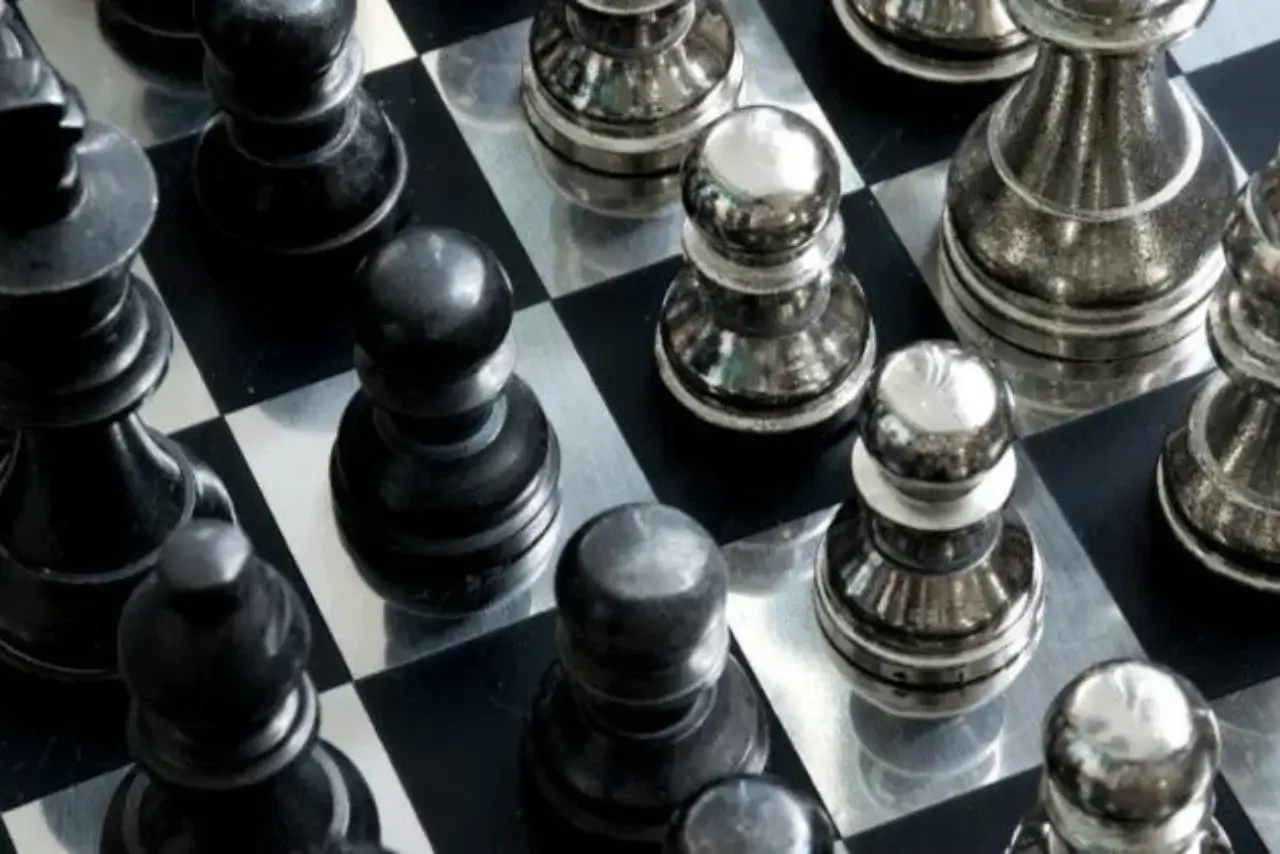In chess, the middlegame is where strategies come alive, where battles are waged, and where champions emerge. This pivotal phase is the heart of the game, where openings transition into dynamic positions, and where you have the power to shape your destiny on the board.
It’s where plans are executed, tactical battles are fought, and positional advantages are sought. Your proficiency in the middlegame can make the difference between victory and defeat, for it’s a critical phase where most chess games are decided.
In the following blog post, we’ll equip you with the knowledge and strategies to navigate the middlegame confidently and emerge victorious.
This post contains affiliate links. Please read our disclosure.
Key Middle Game Concepts
The middlegame in chess is where the true complexity of the game comes to the forefront. It’s a phase where strategic planning, tactical finesse, and positional understanding are crucial. To excel in the middlegame, it’s essential to grasp several key concepts that will guide your decision-making and move selection. Let’s delve into these fundamental concepts:
1. King Safety

In the middlegame, one of your top priorities should always be ensuring the safety of your King. An exposed or vulnerable King can quickly become a target for your opponent’s tactics and attacks. To keep your King secure, consider castling, a special move that tucks it behind a wall of Pawns. This move not only safeguards the King but also connects your Rooks, allowing them to coordinate better.
Avoid weakening your King’s position unnecessarily. Refrain from moving too many Pawns in front of your King, as this can create weaknesses that your opponent might exploit. Keep an eye on open lines near your King, as these can be avenues for threats. Maintaining King safety is not just about physical protection; it’s about peace of mind, allowing you to focus on your middlegame strategy with confidence.
Additionally, when securing your King in the middlegame, consider the timing of your piece development. Don’t rush into overly aggressive moves that neglect King safety. A well-coordinated army with a protected King is more formidable than one that’s scattered and vulnerable. As you plan your middlegame maneuvers, always remember that a safe and sheltered King is the cornerstone of a strong chess position, providing the foundation upon which you can build your winning strategies and tactics.
2. Piece Activity

Active pieces are the engines of your chess army. They can control more squares, create threats, and contribute to your overall strategy. Central control is often the key to piece activity. Your Knights and Bishops should be developed to optimal squares, allowing them to influence the center of the board.
Rooks, on the other hand, should be connected, ideally on open files or semi-open files (files with only your Pawns). This connectivity enhances their ability to support each other and control key areas of the board. An active Queen can exert significant influence on the board, and placing it on squares that allow it to control central and critical squares can give you a strategic advantage.
Active pieces can be a potent deterrent to your opponent’s plans. They can create threats that force your opponent to react defensively, disrupting their plans and allowing you to seize the initiative in the middlegame.
3. Pawn Structure

Understanding the role of Pawn structure is vital in the middlegame. The arrangement of your Pawns can dictate the flow of the game. Consider the Pawn breaks available to you. A Pawn break is a move that opens up lines of attack or challenges your opponent’s Pawn structure. These tactical opportunities can dramatically impact the game’s direction.
Pawn breaks are often used to seize the initiative or create weaknesses in your opponent’s position. For example, if your opponent has an advanced Pawn that’s difficult to defend, launching a Pawn break to challenge it can disrupt their plans and open up new strategic possibilities for you.
Be cautious when considering Pawn breaks. They should align with your overall strategy, and you should weigh the potential risks and rewards. In some cases, holding back on Pawn breaks and maintaining a solid Pawn structure may be the best course of action to prepare for the endgame.
4. Tactical Awareness

The middlegame in chess is a breeding ground for tactical opportunities. Familiarize yourself with common tactical motifs like pins, forks, skewers, discovered attacks, and double attacks. Recognizing these tactics can help you exploit your opponent’s weaknesses or create winning combinations of your own.
A pin occurs when a piece is indirectly attacked and cannot move without exposing a more valuable piece behind it. A fork involves one piece attacKing two or more opponent pieces simultaneously, often leading to a material advantage. A skewer is an attack that places two pieces in line, with the more valuable piece in front. If the less valuable piece moves, the more valuable one is captured. A discovered attack happens when one piece moves, revealing an attack from another piece behind it. A double attack targets two or more opponent pieces or objectives at the same time.
Being tactically aware in the middlegame allows you to spot tactical opportunities, such as winning material or delivering checkmate. It also helps you avoid falling into your opponent’s tactical traps.
5. Planning and Coordination

Having a plan in the middlegame is essential. Your plan should be based on the position’s strengths and weaknesses, as well as your long-term goals. Coordinate your pieces to work harmoniously toward your plan. This might involve launching an attack on your opponent’s King, controlling key squares, or maneuvering for an advantageous endgame.
Planning in the middlegame requires a deep understanding of the position. Assess the Pawn structure, piece activity, and tactical possibilities to formulate an effective plan. Consider your opponent’s potential responses and be ready to adapt your plan if necessary.
Coordination is equally crucial. Ensure that your pieces are working together toward your strategic goals. Rooks should support each other, and your Queen and other pieces should be positioned optimally to contribute to your plan. Effective coordination amplifies your pieces’ strength and enhances your overall middlegame strategy.
With planning and coordinating effectively in the middlegame, you can gain a significant advantage and put pressure on your opponent, positioning yourself for a successful outcome in the later stages of the game.
6. Open Files

Open files are columns on the chessboard that contain no Pawns from either player. Controlling open files is crucial in the middlegame because they provide a clear avenue for your Rooks to become active and dominate the board. Placing your Rooks on open files can exert immense pressure on your opponent’s position, making it challenging for them to defend effectively.
Open files in chess are essential strategic elements on the chessboard. These are columns that remain unoccupied by pawns from either player, creating clear avenues for maneuvering. The significance of controlling open files becomes particularly evident during the middlegame, a phase where tactical battles often determine the course of the game.
Rooks, being the most potent long-range pieces, thrive on open files. Placing your Rooks on these unobstructed columns can lead to a remarkable increase in their activity and influence over the board. With open files at their disposal, Rooks have the freedom to horizontally traverse the board and vertically target key squares. This positions them to exert immense pressure on your opponent’s position, making it a daunting task for them to mount an effective defense.
Mastering the art of controlling open files is a crucial skill in chess. It not only enhances your Rooks’ capabilities but also provides a strategic advantage by restricting your opponent’s options and creating opportunities for devastating attacks. Recognizing and exploiting open files can be the key to gaining the upper hand and ultimately achieving victory in the game of chess.
7. Piece Mobility
Efficient piece mobility is a cornerstone of middlegame strategy. Ensure that your pieces have the freedom to move and exert influence on the board. Knights, in particular, benefit from outposts where they can control key squares. Avoid overcrowding your pieces, which can limit their mobility and coordination. Pieces that lack mobility are often referred to as “bad pieces” and can be a liability in the middlegame.
Efficient piece mobility stands as a fundamental pillar of middlegame strategy in chess. It hinges on granting your pieces the liberty to move and exert their influence across the board. Amongst these pieces, Knights hold a special place, as they thrive when positioned in outposts where they can command critical squares and disrupt your opponent’s plans.
One vital aspect to keep in mind is to prevent overcrowding of your pieces. Overcrowding can lead to limitations in mobility and coordination, which are detrimental in the middlegame. Pieces that become immobilized or lack the ability to swiftly maneuver are often labeled as “bad pieces,” posing a significant liability to your overall strategy. Thus, maintaining the fluidity and freedom of movement for your pieces is paramount, ensuring they remain dynamic and potent contributors to your middlegame plans.
In the middlegame, optimizing piece mobility is a strategic necessity. This not only involves positioning Knights in influential outposts but also avoiding the trap of overcrowding, which can render your pieces ineffective. Fostering efficient piece mobility will enhance your ability to control the board and seize the initiative in the battle for victory.
8. King Activity

While ensuring your King’s safety is paramount, there are situations in the middlegame where activating your King can be advantageous. This often occurs in the endgame when Kings become active central figures. However, in certain positions, especially if the center has opened up, your King can play an active role in supporting your pieces and controlling important squares.
Balancing your King’s safety with strategic activation is a crucial consideration in the middlegame. The primary goal is always to safeguard your King, especially in the early and middle phases of the game. However, as the game progresses into the endgame, the role of the King transforms into that of an active central figure.
In the endgame, an active King is often a key asset. It can help in advancing passed pawns, contributing to piece coordination, and even participating in direct confrontations with your opponent’s King. Nevertheless, this shift towards King activation should be approached with caution and only in positions where it’s safe to do so.
Particularly when the center of the board has opened up, your King can play an active role in supporting your pieces and controlling vital squares. This should always be weighed against potential risks, and careful planning is essential to ensure your King’s safety even as it becomes more engaged in the battle. In essence, the King’s role can evolve, but its safety should remain a top priority, with calculated activations that enhance its influence on the board while minimizing vulnerabilities.
9. Piece Imbalances

Middlegame positions can feature imbalances in terms of piece value and placement. Understanding these imbalances can help you make strategic decisions. For example, if you have a pair of Bishops against your opponent’s pair of Knights, you might aim to open the position to take advantage of the Bishops’ long-range capabilities. Similarly, if you have a spatial advantage, you might want to keep the position closed to limit your opponent’s piece mobility.
In the middlegame, recognizing imbalances in piece value and placement is pivotal for making informed strategic choices. These imbalances can heavily influence your game plan. For instance, consider a scenario where you possess a pair of Bishops while your opponent has a pair of Knights. In such cases, you may strategically aim to open the position. Bishops excel in open positions due to their long-range capabilities, which can give you a significant advantage in controlling key squares and launching attacks.
Conversely, if you find yourself with a spatial advantage, it may be beneficial to keep the position closed. Limiting your opponent’s piece mobility becomes a strategic priority in such situations. By maintaining a closed position, you can make it challenging for your opponent to find effective plans or maneuvers, maximizing the impact of your spatial advantage.
Understanding these imbalances and tailoring your strategy accordingly is a crucial aspect of middlegame play. It enables you to leverage your strengths, exploit your opponent’s weaknesses, and ultimately gain the upper hand in the complex battle of chess strategy.
10. Time Management
In chess, time is an invaluable resource that demands careful management. Every move you make should be purposeful and align with your overarching strategy. This principle becomes even more crucial in tournament settings with time controls.
During the middlegame, striking the right balance between planning and execution is essential. While it’s vital to think strategically and analyze potential moves, it’s equally crucial to avoid spending excessive time on any single move. Doing so can lead to time pressure in the later stages of the game, where quick thinking and decisive moves become increasingly challenging.
So as you navigate the middlegame, keep a watchful eye on your clock, and strive to make moves efficiently while maintaining the integrity of your strategy. Time management is a skill that can significantly impact your performance, and mastering it is key to success in competitive chess.
Conclusion: 10 Important Chess Middlegame Principles for Beginners
Throughout this guide, we’ve unveiled the secrets of mastering the middlegame, equipping you with the knowledge and tools to become a formidable chess player. It’s not just about making moves; it’s about making the right moves with purpose and foresight. With dedication and persistence, you’ll not only navigate the middlegame but also thrive in it. The middlegame is your canvas, and your pieces are the brush strokes that paint your path to triumph. The journey to chess excellence has begun, and the middlegame is where you’ll shine.



